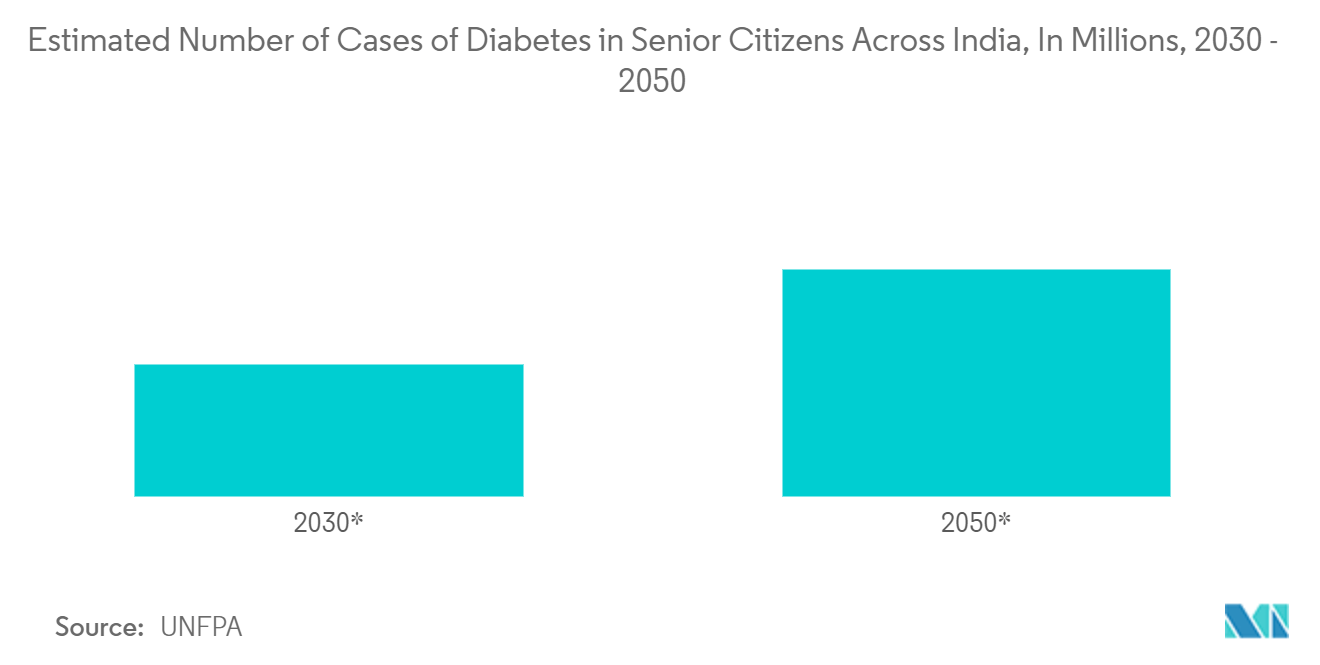Market Trends of Biosensor Industry
Medical is Expected to Witness a Significant Growth
- The global rise in diabetes, especially type 2 diabetes, has led to a greater need for continuous blood glucose monitoring. This drives the demand for biosensors that can accurately measure glucose levels. The demand for reliable glucose biosensors increases as early detection and constant management of blood glucose levels become more critical in preventing complications. UNFPA projected that by 2030, approximately 19.3 million senior citizens in India will be diagnosed with diabetes, with the number expected to rise to around 33.3 million by 2050.
- Growing awareness of the importance of regular blood glucose monitoring among diabetes patients has resulted in higher adoption of glucose biosensors. Government initiatives and healthcare policies aimed at managing diabetes more effectively also promote the use of glucose-monitoring devices, further driving the demand for biosensors. For instance, India has launched an application named mDiabetes to harness mobile technology. The app aims to raise awareness, promote treatment adherence, and instill healthy habits in the general public. Additionally, media campaigns are being conducted to highlight the risk factors associated with diabetes.
- Innovations in biosensor technology, such as continuous glucose monitoring (CGM) systems, which allow non-invasive and real-time monitoring, are becoming increasingly popular. These advancements fuel demand as they offer greater convenience and accuracy than traditional finger-prick methods. In June 2024, Abbott and Dexcom are set to debut the first over-the-counter continuous glucose monitoring systems (CGMs). This launch in the United States aims to promote the broader adoption of these devices.
- Growing demand for cost-effective and practical analytical techniques has spotlighted biosensors in medical drug determinations. Compared to conventional methods, biosensors stand out as unique and effective devices. Various electrode modification materials and biorecognition elements are employed to construct these biosensors for drug determination. Furthermore, multiple construction strategies have been devised to boost biosensor performance. In the coming years, technological advancements are set to deliver cost-effective, sensitive, and selective biosensors for analyzing drugs in both drug formulations and biological samples.

North America is Expected to Hold a Significant Market Share
- North America has one of the highest prevalence rates of diabetes, particularly in the United States. Continuous monitoring has led to substantial demand for glucose biosensors, including glucose monitors (CGMs) and traditional glucose meters. In addition, the region also has a high incidence of cardiovascular diseases, which has driven demand for biosensors that can monitor cardiac biomarkers, enabling early detection and management of heat conditions.
- In February 2024, researchers from Colorado State University are working to transition heart failure screening from laboratories to the comfort of home. Their prototype, an electrochemical biosensor akin to a transparent lateral flow test for COVID-19, can detect two heart failure biomarkers within 15 minutes using only a drop of saliva. This device is designed for individuals at high risk of heart failure, especially those with limited access to hospitals or centralized labs. To develop the handheld testing platform, the team merged two prior innovations - a saliva microfluidic device and a biosensor targeting biomarker proteins Galectin-3 and S100A7.
- The United States FDA (Food and Drug Administration) has expedited the approval processes for biosensor technologies, paving the way for the market entry of new and innovative products into the market. This supportive regulatory environment encourages innovation and drives the demand for new biosensor solutions. Moreover, improved reimbursement policies for biosensor devices, particularly those managing chronic conditions like diabetes and heart disease, have made these technologies more accessible to a broader population, increasing demand.
- North America is home to numerous leading biosensor manufacturers and research institutions that invest heavily in R&D. This focus on innovation drives the development of new and improved biosensors, particularly in areas like non-invasive monitoring, wearable devices, and point-of-care diagnostics. In June 2024, Nix Biosensors, based in the United States, partnered with US Speedskating as the National Team unveiled its 2024-2025 roster. The Nix Hydration Biosensor, a revolutionary device, delivers real-time hydration data, enabling athletes to fine-tune their performance through precise hydration monitoring.


